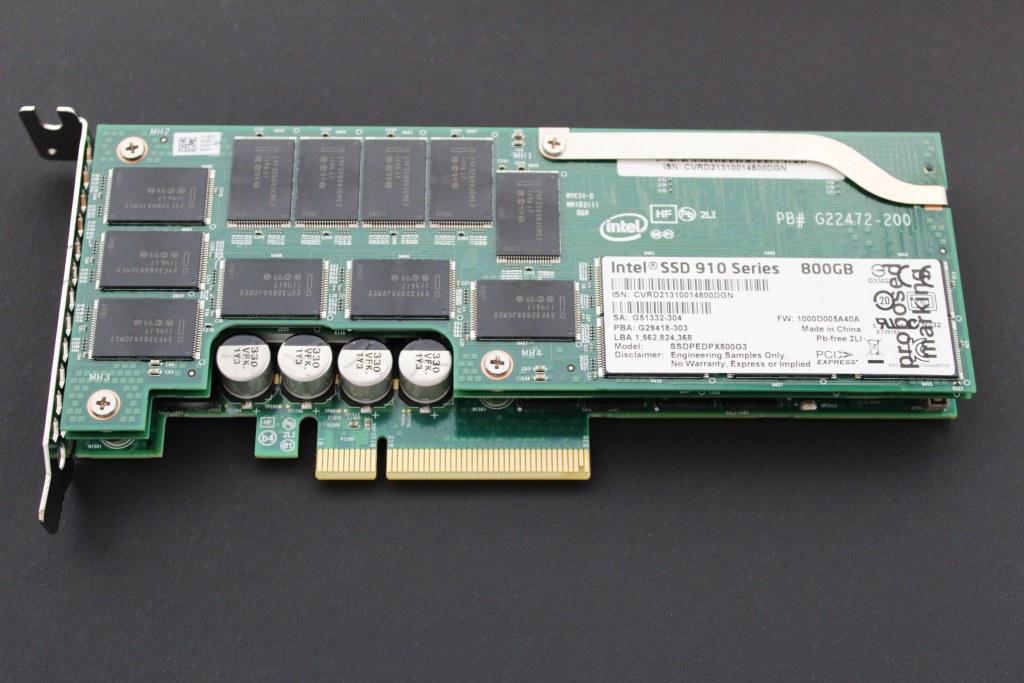NOTE: The full review is now up, which superseeds this article:
Intel 910 PCIe SSD Review “ Amazing Performance Results In Both 400GB and 800GB Configurations
The long awaited Intel 910 PCIe SSD is finally in our hands and we thought we might offer a quick glimpse before our full report next week.
To add to that glimpse, we thought we might also tease our readers with a few preliminary benchmarks as well.
Make no mistake though as this is not a consumer item and is intended for datacenters. We thought our fellow enthusiasts might enjoy a quick look into the high performance datacenter realm. Enjoy!
Our Enterprise Test Protocol consumes 34 hours of consecutive testing, and with the Intel 910 coming in both 400 and 800 GB flavors, we are going to have to run it twice. This is a small price to pay for the leadership position that we have in regards to posting F.O.B., Steady State and overprovisioned drive performance states.
With Enterprise Class SSDs that rely upon compressible performance, we also present the results in both incompressible and compressible formats, for the most complete enterprise testing protocol available. In-depth temperature monitoring rounds out the exclusive data, and readers will not get such detailed results anywhere else.
Our full report should follow along shortly but, for now, lets get a quick look:
The Intel 910 PCIe SSD is a three-level PCB with NAND contained on the top two stacks. There are four controllers on the bottom tier for the NAND and one LSI 2308 PCIe Bridge to present the 910 to the host operating system. You may also notice that the end bracket is half height. This card is surprisingly compact and designed for any application, including low profile server cases.
Unfortunately there wasn’t an included Full Height bracket, so off comes the bracket, and into the test bench!
 The SSD is to the right of the two cards on the left in the picture above. Compared to the two rather large watercooled GPUs next to it, the Intel 910 is very compact. The GPUs are placed for comparison purposes, and the X79 chipset provides the full 40 lanes for PCIe connectivity, which is not provided by mainstream consumer motherboards. By comparison, an 1155 chipset has less than half of the connectivity with a paltry 16 PCIe lanes. For the less-capable mainstream 1155 motherboards, components would have to be removed from other PCIe slots to achieve full performance.
The SSD is to the right of the two cards on the left in the picture above. Compared to the two rather large watercooled GPUs next to it, the Intel 910 is very compact. The GPUs are placed for comparison purposes, and the X79 chipset provides the full 40 lanes for PCIe connectivity, which is not provided by mainstream consumer motherboards. By comparison, an 1155 chipset has less than half of the connectivity with a paltry 16 PCIe lanes. For the less-capable mainstream 1155 motherboards, components would have to be removed from other PCIe slots to achieve full performance.
The 910 fits neatly within the confines of one PCIe slot, even though it is three layers deep and contains 800GB of user-addressable HET-MLC NAND.
ATTO DISK BENCHMARK
In considering the below results, please remember that these are fresh out of box (FOB) and taken simply for a quick enjoyable look at the peaks of this workhorse.
 The Intel 910 tops out just shy of 2 Gb/s in read speed and 1.56 Gb/s in write speeds. There is a high performance setting that consumes more power for the SSD, and these results are in the high performance mode.
The Intel 910 tops out just shy of 2 Gb/s in read speed and 1.56 Gb/s in write speeds. There is a high performance setting that consumes more power for the SSD, and these results are in the high performance mode.
 The SSD Review The Worlds Dedicated SSD Education and Review Resource |
The SSD Review The Worlds Dedicated SSD Education and Review Resource | 
